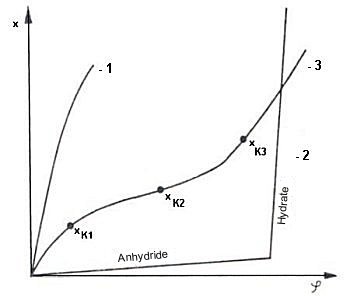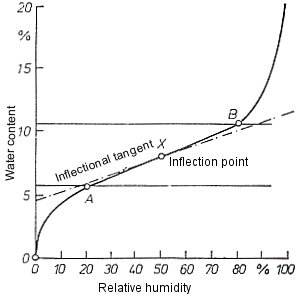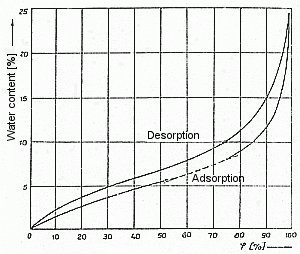- Sorption isotherm rises steeply, i.e. the product is strongly hygroscopic, as is the case with silica gel (desiccant for corrosion protection) or dried fruits.
- In contrast, sucrose or tartaric acid exhibit an abrupt change in the sorption isotherm profile. Over a wide range, until the equilibrium moisture content of approx. 85% is reached, water adsorption is low and the product exhibits scarcely any hygroscopicity (anhydrous form); once the flow moisture point has been reached, sucrose rapidly absorbs large amounts of water vapor, causing it to deliquesce, so explaining the steep rise in the second branch of the curve (formation of hydrate). This type of sorption isotherm is typical of many crystalline goods, such as for example salt, sugar, potash and other fertilizers.
- The third type of sorption isotherm has an S-shaped profile, which most hygroscopic goods exhibit, such as for example wheat or long-life cakes and cookies.
XK1-XK3 in Fig. 5 denote several critical water contents for various technological properties, such as flavor retention, crispness and mold growth in long-life cakes and cookies. The water present around XK1 is strongly adsorbed and occurs at comparatively low relative humidities.
 |
| Figure 5: Types of sorption isotherms; Heiss [16] |
XK2 is the inflection point of the S-shaped sorption isotherm which, in the zone above XK3, is frequently characterized by a more or less steep rise at higher relative humidities. The range between XK1 and XK3 in Fig. 5 is the range of greatest stability in technological properties; in the present case, this range is at water contents of 5.2 - 10.1% and no disadvantageous changes in the product are to be anticipated within these limits.
 |
| Figure 6: Sorption isotherm showing the range (A-B) of greatest stability in technological properties; Acker [27] |
In paper, for example, greatest strength is observed at water contents of between 5.1 and 7% (see Fig 7).
 |
| Figure 7: Sorption isotherms for paper (20°) ---- range of greatest stability of technological properties [45] |